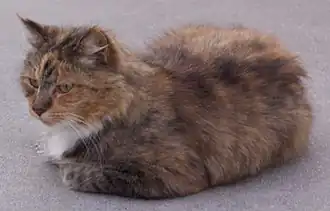香箱座り
Japanese
| Kanji in this term | ||
|---|---|---|
| 香 | 箱 | 座 |
| こう Grade: 4 |
はこ > ばこ Grade: 3 |
すわ > ずわ Grade: 6 |
| goon | kun’yomi | kun’yomi |
Etymology
Compound of 香箱 (kōbako, “incense box”) + 座り (suwari, “sitting”, the 連用形 (ren'yōkei, “continuative or stem form”) of verb 座る (suwaru, “to sit”)). The suwari changes to zuwari as an instance of rendaku (連濁).
Refers to the similarity in shape between an incense box, and a cat when sitting with its front and back paws tucked underneath and its tail wrapped closely along the side of its body.
Pronunciation
- IPA(key): [ko̞ːba̠ko̞zɨᵝɰᵝa̠ɾʲi]
Related terms
References
- 1988, 国語大辞典(新装版) (Kokugo Dai Jiten, Revised Edition) (in Japanese), Tōkyō: Shogakukan
- 2006, 大辞林 (Daijirin), Third Edition (in Japanese), Tōkyō: Sanseidō, →ISBN
- 『もっと知りたい!ねこの気持ち』 (Motto Shiritai! Neko no Kimochi, in Japanese), PHP Institute, pp. 34-35
This article is issued from Wiktionary. The text is licensed under Creative Commons - Attribution - Sharealike. Additional terms may apply for the media files.
